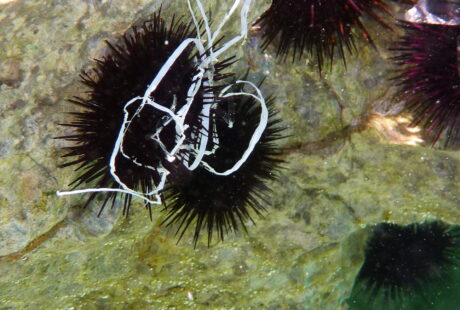Brussels, 16 April 2025 — Today, three years after the European Commission first proposed its Ecodesign for Sustainable Products Regulation (ESPR), it finally published its work plan, laying out its timeline and priorities aimed at boosting sustainable innovation in European products across sectors over the next five years. Seas At Risk welcomes the Commission’s inclusion of textiles, furniture, and tires, but raises the alarm on excluded items such as footwear, plastics, and paints. The marine NGO network warns that for every product that goes unaddressed, thousands of microplastics will continue to wreak havoc on the ocean and human health.
The Commission’s move to omit footwear, plastics, and paints in their work plan is especially worrying, allowing for continued microplastic pollution. Studies (1) (2) single out synthetic textiles as a major contributor to microplastic release into waterways, responsible for up to 35% of aquatic microplastic emissions and ranking the fourth most prevalent source of microplastic emissions by the Commission. The ESPR, one of the Commission’s attempts to curb microplastic pollution by 30% by 2030, provides a golden opportunity to help transition multiple industries at once and turn a new page for sustainable products in the European market. Postponing action on chemical substances is also highly regrettable as toxicity is one of the major issues to be solved through ESPR.
The ESPR, which came into effect in July 2024, is the EU’s flagship initiative for making products sold on the EU market sustainable by design, fully circular and toxic-free. The ESPR focuses on sustainability through improved circularity, energy performance, recyclability, reparability, and durability.
Textiles, furniture, and tires (which combined produce two-thirds of microplastic emissions) (3) are among the priority sectors the Commission identified in 2024 (4), while the Commission chose to sideline other priority sectors for now, at least until 2028, but most likely until 2035. The five-year work plan – already extended from three years – with an intermediate review in 2028, can only deliver real change if all identified priority sectors stay on the Commission’s agenda.
Frédérique Mongodin, Senior Marine Little Policy Officer, said: “With textiles behind a significant share of ocean microplastic pollution, we’re glad the most obvious priority was kept in the European Commission’s work plan. Still, just as every organism in the ocean — from tiny phytoplankton to great whales — plays a vital role in the ecosystem, every piece of plastic pollution — whether macro, micro, or nano — has the potential to harm it. To truly protect marine life, ecosystems, and human health, the Commission can’t afford to reduce ambition. The job isn’t done until our planet is free from all forms of microplastic pollution.”
She added: “We urge the Commission to ensure that ‘not now’ does not become ‘a decade too late’ when addressing chemicals, paints, plastics, and other overlooked items. Postponing action on microplastics today only guarantees more pollution tomorrow.”
Notes
- Boucher, J. & Friot, D. Primary Microplastics in the Oceans: Global Evaluation of Sources (International Union for Conservation of Nature and Natural Resources (IUCN), 2017)
- Article 49 Regulation (EU) 2024/1781 https://eur-lex.europa.eu/eli/reg/2024/1781/oj
Posted on: 16 April 2025


